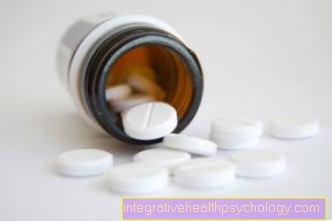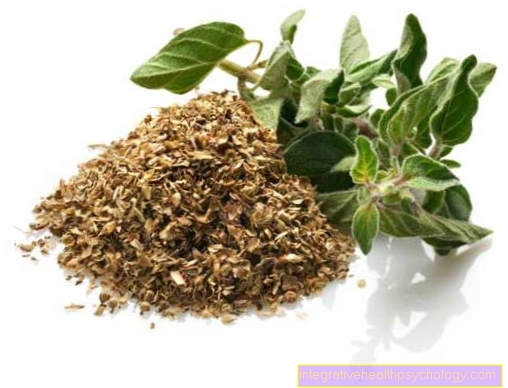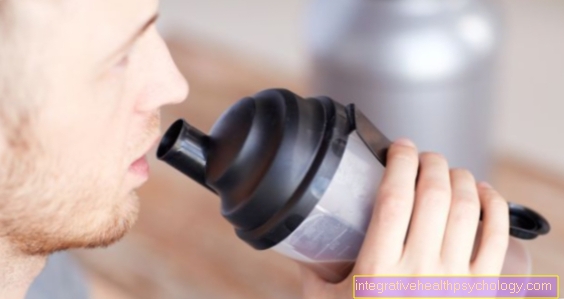Anti-inflammatories
introduction
Anti-inflammatories are drugs that are designed to suppress inflammation in the body. They are therefore always used when an inflammatory reaction takes place in the body and this reaction is to be suppressed. Inflammatory reactions take place in many diseases, such as allergies, rheumatoid arthritis or bronchitis.

Anti-inflammatory drugs are also known as so-called anti-inflammatory drugs or anti-inflammatory drugs. One differentiates in general steroidal, nonsteroidal and herbal anti-inflammatory drugs. The best known and are the nonsteroidal anti-inflammatory drugs, the so-called NSAIDs. These are also the most commonly used in general.
The main representatives of this group are aspirin®, Ibuprofen, Diclofenac, as well as the coxibs. Examples of the group of steroidal anti-inflammatory drugs are Dexamethasone or Prednisolone. For example, the oil from the arnica plant is a well-known herbal anti-inflammatory agent.
Steroidal anti-inflammatory drugs
Form of administration and dosage
Steroidal anti-inflammatory drugs can principally be used as Tablet, intravenously through the vein, as Aerosol inhaled as cream, or injected into a joint. The type of dosage form and the dosage depends on the disease to be treated and the pharmacological properties of the active ingredient.
Steroids are used in almost all of medicine. Among other things, steroids are used in rheumatology, pulmonology (lung medicine), dermatology (skin medicine), hematology-oncology, neurology (neurology), infectiology, ophthalmology, gastroenterology and nephrology.
For example, during a Rheumatoid arthritis flare-ups 50 mg Prednisolone taken as a tablet. If one only wants to carry out a local therapy, then the administration of 10-40 mg triamcinolone directly into the joint with a syringe is indicated.
In addition, steroids are also used Substitution therapy used to at a Adrenal insufficiencySo when the adrenal gland can no longer sufficiently produce the body's own hormone cortisol, it can guarantee a sufficient level of steroids in the body.
Mode of action
Steroidal anti-inflammatory drugs work in different ways. First tie them to the body's own Glucocorticoid receptors. Thus, they intervene in the regulation of pro-inflammatory and anti-inflammatory proteins, ultimately making them, like non-steroidal anti-inflammatory drugs, the so-called Cyclooxygenase Type II inhibit. This in turn leads to a Decrease in inflammation, fever, swelling, and pain.
Interactions
Steroidal anti-inflammatory drugs have a number of interactions that need to be considered. For Prednisolone applies that the effect of estrogens, as they are in the "pill“Are included, can be amplified. The Weaken effect on the other hand, drugs such as the antibiotic can Rifampicin.
In addition, it is known that steroids or prednisolone the Affect the mode of action and side effects of other drugs can. The simultaneous use of steroids and nonsteroidal anti-inflammatory drugs leads to a higher number of gastric and intestinal ulcers. Therefore, particular attention should be paid to newly occurring stomach pains.
The Hypoglycemic effects of antidiabetic drugs on the other hand, by taking steroids at the same time reduced.
Contraindications
Steroidal anti-inflammatory drugs have very few absolute contraindications. Only with one Hypersensitivity The steroidal anti-inflammatory drugs must not be taken against the active ingredient or its other ingredients. However, there are a number of them Precautionsto consider when using a steroidal anti-inflammatory drug.
As this group of anti-inflammatories is one Downregulation of the immune system an anti-infectious therapy may have to be carried out. This applies, for example, to a simultaneous acute infection with herpes zoster. Furthermore, the laboratory diagnosis of an infection can be made more difficult by the anti-inflammatory measures. Also at Pre-existing illness how high blood pressure or Diabetes mellitus monitoring is advisable. In principle, therapy with a steroidal anti-inflammatory agent should always be adequately monitored by a doctor.
Side effects
Steroidal anti-inflammatory drugs have a large number of side effects. Among other things, a Weight gain, one Edema formation as well as a Diabetes mellitus occur. It can also be Stomach and intestinal discomfort that come mainly in the form of Stomach ulcer may occur.
That too Blood count may change after long steroids use, making it mainly one Increase in white blood cells comes. The eyes can also be affected by the side effects. Taking steroids can cause one cataracts and cataracts come. In addition, the psyche can be impaired as a side effect depression is known.
Non-steroidal anti-inflammatory drugs
Form of administration and dosage
Non-steroidal anti-inflammatory drugs can in principle also be used as Tablet, intravenous via the vein or as cream are given. Basically, find nonsteroidal anti-inflammatory drugs Use in the treatment of pain and inflammation. Here, too, the type of administration and the dosage depend on the disease to be treated.
At a bruise of a body part, for example, one leads a local ointment application With Diclofenac (Voltaren®). At a ankylosing spondylitis can for example 800mg three times a day Ibuprofen be taken. This type of anti-inflammatory is most widespread among the population, for example in the treatment of headaches or joint pain.
Mode of action
Nonsteroidal anti-inflammatory drugs have an effect on inhibition the so-called Cyclooxygenase Type I. and II an inhibition of prostaglandin synthesis. Prostaglandins are part of the group of tissue hormones and normally promote inflammation or a rise in fever. If the production of these hormones is now inhibited, it comes to one Decrease in inflammation, fever, swelling, and pain. In addition inhibit nonsteroidal anti-inflammatory drugs the Platelet aggregationwhereby the Affects blood clotting which is used, among other things, in the therapy of coronary heart disease.
Interactions
Nonsteroidal anti-inflammatory drugs cause a variety of interactions that must be considered. It is known that nonsteroidal anti-inflammatory drugs can also help Affect the mode of action and side effects of other drugs can. The simultaneous use of nonsteroidal anti-inflammatory drugs and steroids leads to a higher number of gastric and intestinal ulcers.
In addition, nonsteroidal anti-inflammatory drugs can be a Weakening the effect of diuretics (Drainage medication) and Antihypertensive drugs (Antihypertensive drugs).
Besides, the simultaneous use of non-steroidal anti-inflammatory drugs and alcohol not recommended, as there may be an increase in side effects.
Contraindications
The non-steroidal anti-inflammatory drugs in particular have a large number of contraindications to be considered. Nonsteroidal anti-inflammatory drugs should not be used with a Hypersensitivity compared to the active ingredient group. If an asthma attack or shortness of breath occurs while taking non-steroidal anti-inflammatory drugs, then this group of drugs must no longer be taken. With existing Gastric and intestinal bleeding or has occurred repeatedly in the past Inflammation of the gastric mucosa As well as stomach ulcers, nonsteroidal anti-inflammatory drugs are allowed not used become.
Should treatment with this group of drugs be necessary, one should also use one Drug used to inhibit stomach acid take to protect the mucous membrane. These drugs will Proton pump inhibitors called (for example Omeprazole or pantoprazole).
Likewise is one Bleeding disorder a contraindication to taking nonsteroidal anti-inflammatory drugs. In addition, anti-inflammatory drugs of the non-steroidal anti-inflammatory drug type are allowed not with heart disease like a heavy one Heart failure or coronary artery disease be taken. In the case of other severe organ defects such as severe liver or kidney defects, these must also not be used.
Side effects
Nonsteroidal anti-inflammatory drugs have a variety of side effects that can vary depending on the dose and patient. Kick most often Side effects of the gastrointestinal tract on. Here it can be especially Stomach ulcer who subsequently come to a Gastric perforation as well as bleeding. It also happens frequently Nausea, vomiting, gas, constipation and Inflammation of the gastric mucosa. Furthermore, side effects occur in the area of the Cardiovascular system on. Often edema, high blood pressure and heart failure occur when taking non-steroidal anti-inflammatory drugs. Another important side effect is that increased incidence of heart attacks and strokes.
Herbal anti-inflammatory drugs
Form of administration and dosage

There are a variety of them herbal anti-inflammatory drugsthat have to be administered and dosed in different ways. arnica for example, is a well-known herbal anti-inflammatory drug that is often found in Ointment form is administered. Here you rub the Arnica ointment once or twice a day.
Mode of action
About the herbal anti-inflammatory drug arnica is no special mechanism of action known. However, this does not apply to all herbal anti-inflammatory drugs, but is different for each herbal ingredient. Arnica probably works, with the plant ingredient helenalin playing an important role Inhibition of so-called cytokines. Cytokines are also tissue hormones that normally cause inflammation in the body.
Interactions
About the herbal anti-inflammatory arnica are no known interactions. However, this does not generally apply to all herbal anti-inflammatory drugs, but is different for each herbal ingredient and should therefore always be looked up.
Contraindications
A well-known classic herbal anti-inflammatory agent is, for example, the arnica plant. This herbal anti-inflammatory should never be used in a Hypersensitivity towards this active ingredient. If, for example, there is hypersensitivity to chamomile flowers or peanut oil, then arnica must also not be administered. In addition, arnica products should not be used on damaged skin. In addition, arnica should not be used in children under one year of age.
Side effects
A few side effects are known about the herbal anti-inflammatory arnica. However, these do not apply to all herbal anti-inflammatory drugs, but are again different for each herbal ingredient. It can be with a Hypersensitivity versus arnica or peanut oil allergic skin reactions occur. So kick Reddening of the skin, itching, or swelling on, the administration of arnica should be discontinued and a Consulted a doctor become.
Metabolism
The metabolism of a drug depends, among other things, on whether it was taken as a tablet, injected into a vein, applied as an ointment or administered by inhalation.
For the steroid Prednisolonethat is taken as a tablet, for example, is considered to be his maximum concentration in the blood after about two hours reached after it has been absorbed in the stomach and intestines. In the blood, it then binds to various proteins such as albumin. In the liver arrived, it will then converted into hormonally inactive products. These inactive products will be excreted via the kidneys. It is important to note that the Duration of action of prednisolone with 18-36 hours is much longer than the detectability in the blood. These times change with severe liver damage. Inhaled one prednisolone unfolds its Effect for the most part only in the bronchi and not in the whole body. This is important in relation to the side effects that are normally associated with taking steroids.
The non-steroidal anti-inflammatory drug Diclofenactaken as a tablet is usually achieved his highest concentration after two hours in blood. It will above all absorbed by the intestine. After the intestinal passage, a large part of the diclofenac becomes inactivated in the liverwhat is known as the so-called first pass effect. About 30% of the active ingredient is excreted via the intestines and faeces and about 70% via the kidneys.
Will diclofenac injected into the muscle, it reaches his highest concentration in the blood already after about 15 minutes. With a gift as Suppositories the highest concentration is reached after half an hour.
About the herbal anti-inflammatory drug arnica is no specific metabolism known. However, this does not apply to all herbal anti-inflammatory drugs, but is different for each herbal ingredient.


























.jpg)


